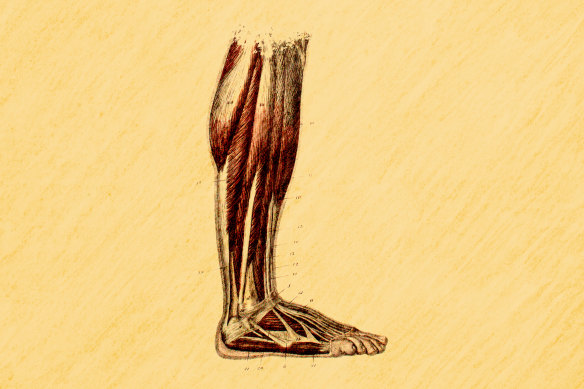This was published 4 months ago
A leg or a useless paperweight: When can a severed limb be reattached?
Reattaching a severed limb after a traumatic amputation is a race against time, infection and dying tissue.

How long a limb has been detached is a major factor.Credit: Stephen Kiprillis
When a surfer’s leg washed up on a NSW beach after he was mauled by a three-metre shark, the speculation began. Would surgeons reattach it?
The answer was no. “Spot something missing?” 23-year-old Kai McKenzie joked in an Instagram post with a photo of the surfer and loved ones, his right leg missing.

‘Spot something missing?’: Surfer Kai McKenzie has shared a joke on Instagram.Credit: Instagram
Reattaching a limb is a race against time, infection and dying tissue.
So what are the chances that a leg, arm, hand or finger can be sewn back on? And even when it can be done, should it be?
When can a severed limb be reattached?
While fingers and partial hands are often successfully reattached, larger limbs such as arms and legs present more challenges due to their size and complexity, said Sydney orthopaedic trauma surgeon Professor Ian Harris.
“The further up the limb you go, the worse the results,” Harris said.
That’s why surgeons rarely attempt upper limb replantations (the medical term for surgically reattaching a body part).
“But there is more hope of success for legs below the knee and close to the ankle,” said Anand Deva, a professor of plastic and reconstructive surgery at Macquarie University.
The most important consideration: how long has the limb been off? After roughly four to six hours the dying muscle is too far gone.

Plastic and reconstructive surgeon Professor Anand Deva.
“When that window closes, you can pump all the blood you want into them, they’re already dead,” Harris said.
Keeping the limb cool buys you some time, said Deva. “But eight hours is really pushing it for bigger muscles.”
Then there’s contamination, for instance from being in water (rivers are the worst, Harris said), or the animal that mauled the limb.
The type of injury is crucial. A clean cut improves the likelihood of successful reattachment compared with a limb mangled by crushing or twisting. “A crush amputation is probably the worst kind,” Deva said.
A patient’s age and health also influence outcomes, with younger patients generally experiencing better nerve recovery and healing.
How are amputated limbs reattached?
Without getting too technical: “The sequence is skeleton, arteries, nerves, veins and finally the skin,” Deva said.
“We can’t reattach a limb until you have a stable skeleton. The next step is blood flow. It’s critical to get arterial blood flow, into the limb or digits as quickly as possible,” Deva said.
In Deva’s experience, the sensory nerves are most critical.
“If the muscle is working, but they can’t feel their limb, then they are going to repeatedly injure themselves,” he said.
Why is it harder to save a leg than a finger?
“Technically, we can reattach anything, but if it’s dead or it’s going to die, why would we do that?” Harris said.
“Fingers are actually harder to reattach because the vessels are very small. It’s easier to sew some big nerves and blood vessels together in the thigh.
“The further up [the limb], the longer the nerves have to regenerate. If it’s above the knee, you’re talking 50 to 100 centimetres. By the time that nerve’s regrown, the muscles have wasted away, and it doesn’t work very well,” Harris said.
And it takes months or years for that nerve to grow and then reinnervate both sensory and motor function, Deva said.
Should surgeons always attempt to reattach a limb?
“The general rule of thumb is ‘life before limb’,” Harris said. “If the person is not well enough to go through that procedure – if they have a heart condition or diabetes – then you’re risking their life by trying to put their limb back on.”
It’s always a difficult conversation, Deva said, “especially when a patient asks you, ‘Can you just try to put it back on, doc?’ I say, ‘Yes, I can, but I think you’d be better off with a prosthetic.’
“You can be the heroic surgeon who reattached a leg or an arm but the problems don’t surface for months later when the limb is a liability. Just dead tissue that keeps getting injured or infected.”
David Morgan, president of the Australasian Society of Plastic Surgeons agreed: “If the nerves don’t recover fully … it basically becomes a large paperweight.”
Can you demand a doctor reattach your limb?
A major replantation involves extensive consultation with several senior specialists, including vascular surgeons, plastic surgeons, trauma surgeons and orthopaedic surgeons.
It can be a controversial decision when you factor in the complexity of the procedure, the complications and the fact that modern prosthetic limbs are often far superior to a damaged, replanted appendage.
Harris recalled the case of a young man who had lost his arm. His surgeons argued over whether to reattach. The surgeons who argued in favour of replantation won, and the patient died in the process.
For Deva, the decision must be the surgeon’s, not the patient’s.
“It’s not a negotiation,” he said. “Just ‘giving it a go’ is not a good reason to try.”
There have been cases where a severely damaged, functionally useless leg has been replanted despite a prosthesis being the better option, but the patient was happy because they had their leg.
“I’ve been involved in a few cases where a patient has had a limb reattached, and two or three years later they begged to take the thing off,” Deva said. “That is a real tragedy.”
With Angus Thomson